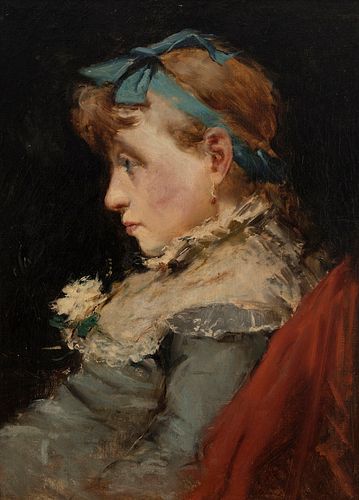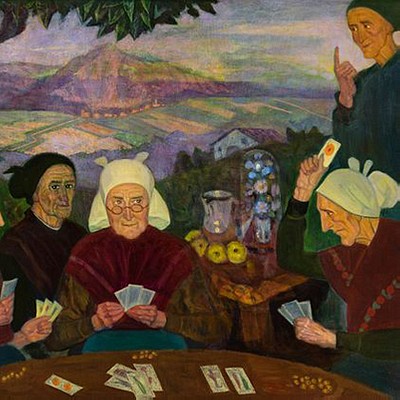JOAQUÍN SOROLLA Y BASTIDA (Valencia, 1863 - Cercedilla, Madrid, 1923). "Girl", 1882. Oil on canvas.
Lot 78
About Seller
Setdart Auction House
Carrer Aragó 346
Barcelona
Spain
Setdart Subastas was born in 2004 and is currently the first online art auction in Spain with solidity, prestige and reliability guaranteed by our more than 60,000 users. Setdart has a young, dynamic and enterprising team ready to successfully manage the purchase and sale of art works through custom...Read more
Estimate:
EUR€18,000 - EUR€20,000
$19,354.84 - $21,505.38
Absentee vs Live bid
Two ways to bid:
- Leave a max absentee bid and the platform will bid on your behalf up to your maximum bid during the live auction.
- Bid live during the auction and your bids will be submitted real-time to the auctioneer.
Bid Increments
| Price | Bid Increment |
|---|---|
| EUR€0 | EUR€10 |
| EUR€200 | EUR€25 |
| EUR€500 | EUR€50 |
| EUR€1,000 | EUR€100 |
| EUR€3,000 | EUR€200 |
| EUR€5,000 | EUR€500 |
| EUR€10,000 | EUR€1,000 |
| EUR€20,000 | EUR€2,000 |
| EUR€50,000 | EUR€5,000 |
About Auction
By Setdart Auction House
Dec 14, 2021
Set Reminder
2021-12-14 08:00:00
2021-12-14 08:00:00
America/New_York
Bidsquare
Bidsquare : 19th & 20th Century Fine Art
https://www.bidsquare.com/auctions/setdart-auction-house/19th-20th-century-fine-art-7992
Gaudi, Sorolla, Torres Garcia, Maclet, TSUGUHARU FOUJITA, Benjamin Palencia Setdart Auction House sofia@setdart.com
Gaudi, Sorolla, Torres Garcia, Maclet, TSUGUHARU FOUJITA, Benjamin Palencia Setdart Auction House sofia@setdart.com
- Lot Description
JOAQUÍN SOROLLA Y BASTIDA (Valencia, 1863 - Cercedilla, Madrid, 1923). "Girl", 1882. Oil on canvas. Attached certificate of authenticity issued by Mrs. Blanca Pons Sorolla. Work exhibited at: Exhibition tribute to Sorolla. Sala Parés, 1948 (Reproduced in the catalog in black and white). Work reproduced in: Bernardino de Pantorba, The life and work of Joaquín Sorolla. Biographical and critical study. Madrid, 1970, nº1152. - Catalogue Raisonné of the artists BPS 256. Presents label of the Sala Parés (Barcelona) and the Montenegro Gallery (Vigo). Measurements: 49.5 x 37.5 cm; 63 x 50 cm (frame). During the years 1881 and 1882 Sorolla, traveled frequently to Madrid, where he came into contact with the painting of the Prado Museum in Madrid, opting for the baroque decided to copy the great masters such as Velázquez or Ribera. In this painting of a young Sorolla, we can already appreciate that loose brushstroke so characteristic of his painting, although it is still somewhat timid, in relation to his later paintings. The darkness of the background lets the influence of the great baroque masters pulsate. However, the luminosity of the white of the neck, added to the pearly and pink skin of the protagonist, allows us to perceive a certain luminosity in the scene. Already in his school days, Joaquín Sorolla showed his fondness for drawing and painting, attending in the afternoons the drawing classes taught by the sculptor Cayetano Capuz at the School of Artisans. Awarded upon finishing his preliminary studies at the Escuela Normal Superior, he entered the prestigious Escuela de Bellas Artes de San Carlos in Valencia in 1879. Also, during his visits to Madrid in 1881 and 1882, he copied paintings by Velázquez, Ribera and El Greco at the Prado Museum. Two years later he obtained a great success at the National Exhibition of Fine Arts with a history painting, which stimulated him to apply for a scholarship to study at the Spanish Academy of Fine Arts in Rome. Having achieved his goal, in 1885 Sorolla left for Rome, staying in Paris for several months before arriving. In the French capital he was impressed by the paintings of the realists and the painters who worked outdoors. At the end of his years in Rome he returned to Valencia in 1889, settling in Madrid the following year. In 1892 Sorolla showed a new concern in his art, becoming interested in social problems by depicting the sad scene of "¡Otra Margarita!", awarded a first class medal at the National, and the following year at the International in Chicago. This sensitivity would remain in his work until the end of the decade, in his performances on the Valencian coast. Gradually, however, the Valencian master will abandon the themes of unhappy children that we see in "Triste herencia", which had been awarded a prize at the Universal Exhibition in Paris in 1900 and at the National in Madrid a year later. Encouraged by the success of his resplendent images of the Mediterranean, and stimulated by his love of the light and life of its sunny beaches, he focused on these scenes in his works, more cheerful and pleasant, with which he would achieve international fame. In 1906 he held his first individual exhibition at the George Petit Gallery in Paris, where he also demonstrated his skills as a portraitist. In 1908 the American Archer Milton Huntington, impressed by the artist's exhibition at the Grafton Gallery in London, sought to acquire two of his works for his Hispanic Society. A year later he himself invited Sorolla to exhibit at his institution, resulting in an exhibition in 1909 that was a huge success. The relationship between Huntington and Sorolla led to the most important commission of the painter's life: the creation of the immense canvases destined to illustrate, on the walls of the Hispanic Society, the regions of Spain.
- Shipping Info
-
In-house shipping available. Please inquire at admin@setdart.com.
-
- Buyer's Premium



 EUR
EUR CAD
CAD AUD
AUD GBP
GBP MXN
MXN HKD
HKD CNY
CNY MYR
MYR SEK
SEK SGD
SGD CHF
CHF THB
THB

















